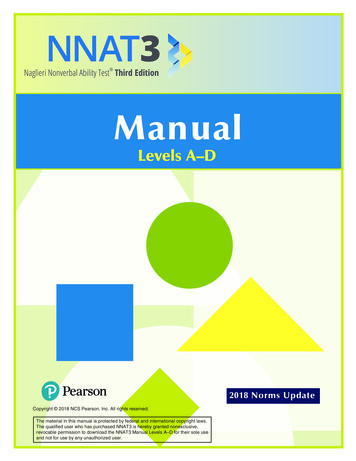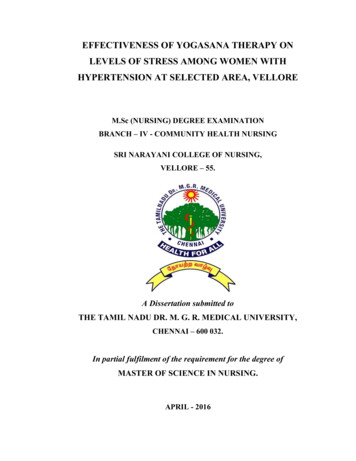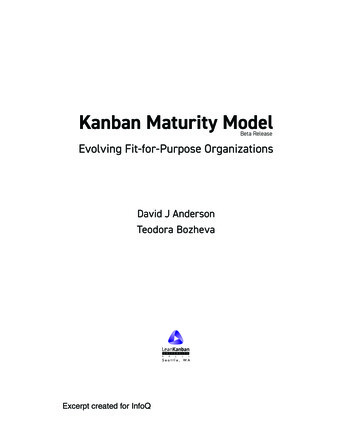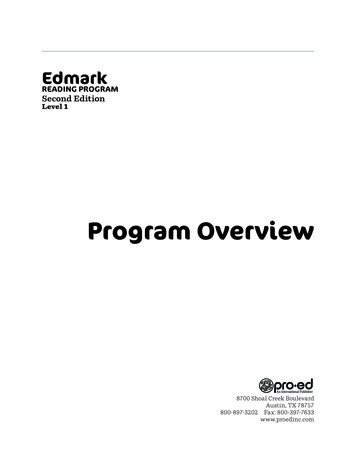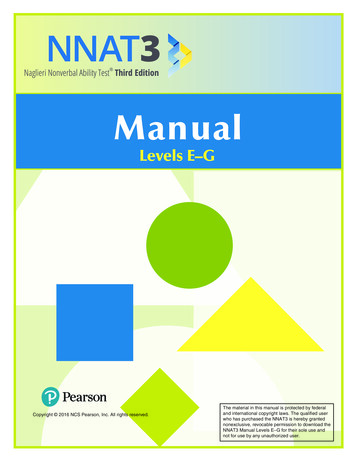
Transcription
ManualLevels E–GCopyright 2016 NCS Pearson, Inc. All rights reserved.The material in this manual is protected by federaland international copyright laws. The qualified userwho has purchased the NNAT3 is hereby grantednonexclusive, revocable permission to download theNNAT3 Manual Levels E–G for their sole use andnot for use by any unauthorized user.
Copyright 2016 NCS Pearson, Inc. All rights reserved. Portions of this work were previously published.Levels E–G normative data copyright 2016 NCS Pearson, Inc.Warning: No part of this publication may be reproduced or transmitted in any form or by any means, electronic or mechanical,including photocopy, recording, or any information storage and retrieval system, without the express written permission of thecopyright owner.Pearson, Naglieri Nonverbal Abilities Test, and NNAT are trademarks, in the US and/or other countries, of PearsonEducation, Inc., or its affiliates.NCS Pearson, Inc., 5601 Green Valley Drive, Bloomington, MN 55437
About the AuthorJack A. Naglieri, Ph.D., is Research Professor at the Curry School of Educationat the University of Virginia, Senior Research Scientist at the Devereux Centerfor Resilient Children, and Emeritus Professor of Psychology at George MasonUniversity. He is a Fellow of APA Divisions 15 and 16, recipient of the 2001 SeniorScientist Award for APA Division 16 and the 2011 Italian American PsychologyAssembly Award for Distinguished Contributions to Psychology, is a Diplomatein Assessment Psychology, earned a license as a School Psychologist in Virginiaand Ohio, and earned School Psychology certifications in New York, Georgia,Arizona, and Ohio. Dr. Naglieri has focused his professional efforts on theoreticaland psychometric issues concerning intelligence, cognitive interventions, diagnosisof learning and emotional disorders, and theoretical and measurement issuespertaining to protective factors related to resilience.Dr. Naglieri is the author or coauthor of more than 250 scholarly papers, books,and tests. His scholarly research includes investigations related to exceptionalitiessuch as mental impairment, specific learning disabilities, giftedness, and AttentionDeficit Disorder; psychometric studies of tests, such as Wechsler’s scales ofintelligence, cognitive assessments, and the Kaufman assessments of cognitiveabilities; and studies of race, gender, and ethnic differences in cognitive processing;fair assessment using nonverbal and neurocognitive processing tests; identificationof gifted minorities, IDEA and identification of specific learning disabilities; andcognitively based mathematics interventions. He has authored various books,including Essentials of CAS Assessment (Naglieri, 1999), and coauthored bookssuch as Assessment of Cognitive Processes: The PASS Theory of Intelligence(Das, Naglieri, & Kirby, 1994), Helping Children Learn: Intervention Handoutsfor Use at School and Home, Second edition (Naglieri & Pickering, 2010),Essentials of Wechsler Nonverbal Assessment (Brunnert, Naglieri, & Hardy-Braz,2009), and Helping All Gifted Children Learn: A Teacher’s Guide to Using theNNAT2 (Naglieri, Brulles, & Lansdowne, 2009). Dr. Naglieri has also coeditedbooks such as Handbook of Assessment Psychology (Graham & Naglieri, 2002),Assessment of Autism Spectrum Disorders (Goldstein, Naglieri, & Ozonoff, 2009),Assessing Impairment: From Theory to Practice (Goldstein & Naglieri, 2009), APractitioner’s Guide to Assessment of Intelligence and Achievement (Naglieri &Goldstein, 2009), and Handbook of Executive Function (Goldstein & Naglieri,2013).Dr. Naglieri’s scholarly efforts also include development and publication of testsand rating scales. He began this work in the mid-1980s with the publication of theMatrix Analogies Tests (Naglieri, 1985), which became the Naglieri NonverbalAbility Test—Multilevel Form (Naglieri, 1997), Naglieri Nonverbal Ability Test—Second Edition (2008) and now the Naglieri Nonverbal Ability Test—Third Editioni
(2016). He also published the Wechsler Nonverbal Scale of Ability (Wechsler &Naglieri, 2008), the Devereux Student Strength Assessment (LeBuffe, Shapiro,& Naglieri, 2009), the Autism Spectrum Rating Scale (Goldstein & Naglieri,2009), the Comprehensive Executive Functioning Index (Naglieri & Goldstein,2013), and the Cognitive Assessment System—Second Edition (Naglieri, Das andGoldstein, 2014).ii
TABLE OF CONTENTSAbout the Author .iChapter 1Purpose and Design of NNAT3, Levels E–G .1Design .2Administration .3Uses of NNAT3 .4Chapter 2Interpretation and Applications .5Types of Scores.5Applications and Uses of NNAT3 .8What does the NNAT3 Measure? .9Chapter 3Standardization, Norms Development, and Reliability . 13Standardization and Norms Development . 13Equating Paper-and-Pencil-Based Tests WithComputer-Based Tests .15Norms Construction . 16Reliability . 17Appendix A: Scaled Scores Corresponding to Raw Scoresby Level and Administration Mode. 20Appendix B: Naglieri Ability Indexes Corresponding to Scaled Scores by Age . 22Appendix C: Naglieri Ability Index (NAI) Scores with Corresponding PercentileRanks, Stanines, and Normal Curve Equivalents (NCES) .34Appendix D: List of Participating Schools .36References . 39iii
iv
LIST OF TABLESTable 1.1. Grade and Valid Age Range for Each NNAT3 Level .4Table 3.1. Number of Cases in the NNAT3 Levels E–G Norm Sample, by Age. 14Table 3.2. Demographic Characteristics of the NNAT3 Levels E–G Norm Sample .15Table 3.3. Reliability and SEM by Level and Grade . 18v
vi
PURPOSEANDCHAPTER 1DESIGN OF NNAT3, LEVELS E–GThe Naglieri Nonverbal Ability Test —Third Edition (NNAT3), Levels E–G, is abrief, nonverbal measure of general ability that can be group administered in online orpaper format in about 30 minutes to students aged 9:6 to 17:11. For information aboutthe NNAT3 Levels A–D, refer to the NNAT3 Levels A–D Manual. For informationabout NNAT3 Levels E–G (grades 5–12), please see the NNAT3 Levels E–G Manual.The purpose of the NNAT3 is to measure general ability using abstract designs whichare accessible to a wide variety of students including those with limited educationalexperiences, those who come from diverse cultural, socioeconomic, or linguisticbackgrounds, and those who have language disabilities, autism spectrum disorder,or are deaf or hard of hearing. Because the NNAT3 items consist of geometricshapes that are universal and have no verbal content, and the directions are pictorialwith minimal verbal instructions, NNAT3 has great utility as part of the process ofidentifying students for gifted/talented educational programs, especially for membersof groups that have been underrepresented.The NNAT3, Levels E–G, is a renorming of NNAT2 (Naglieri NonverbalAbility Test—Second Edition, Naglieri, 2007). That is, the items and content in theNNAT3 are the same as in NNAT2—only the norms are new. The NNAT3 is basedon the Naglieri Nonverbal Ability Test—Multilevel Form (NNAT-ML; Naglieri, 1997).The original instruments in this series were the Matrix Analogies Test—ExpandedForm (MAT-EF; Naglieri, 1985a) and Matrix Analogies Test—Short Form (MAT-SF;Naglieri, 1985b).The NNAT3 measures the student’s ability to look at a pattern that has a missingsection, understand the relationships among the parts, and determine which of the fiveoptions correctly fills the gap. An example is shown in Figure 1.1. In this example,the student needs to comprehend the relationships between the two diamonds in thetop row and the diamond and triangle in the left column. When the horizontal andvertical relationships are understood, then the answer (option 1) becomes clear.Figure 1.1. Example of an NNAT3 Item1
NNAT3 Manual Levels E–GThe kind of thinking required to solve a question like this one, made up ofshapes and colors, is essentially the same as the thinking required to solve a verbalquestion such as “Girl is to woman as boy is to . . . ?” In this case the relationshipsbetween girl and woman as well as girl and boy must be understood to arrive at theanswer “man.” Although the thinking is the same whether one is reasoning withwords or with shapes, one type requires knowledge of a particular language and,usually, the ability to read, whereas the other type does not require these skills.The NNAT3 measures general ability—a widely used concept that has beenstudied since the early 1900s. Naglieri, Brulles, and Lansdowne (2009) describedgeneral ability as what enables people to solve a number of different kinds of problemsthat may involve words, pictures, sounds, or numbers. It may also require verbal,quantitative, or nonverbal reasoning; memory; sequencing; pattern recognition;insights; drawing inferences; and analyzing simple and complex ideas. In modernconceptions of ability, the particular type of thinking that NNAT3 questionsrequire—that is, seeing relationships among components of the question and thinkingof rules that can explain those relationships—is considered to be closely related togeneral ability (Carroll, 1993). Thus, it is not surprising that the various versions ofNNAT have been found to be good predictors of academic achievement for studentsin diverse racial/ethnic groups or from diverse language backgrounds. The power ofthe concept of general ability makes this a useful approach for large-scale testing.DesignThe NNAT3 Levels E, F, and G are designed specifically for students inthe corresponding grades respectively: 5–6, 7–9, and 10–12. Each form consistsof 48 items arranged in approximate order of difficulty.The content of the NNAT3 items vary in difficulty and structure. Forexample, the easiest items present a large rectangle with a piece missing (see anexample in Figure 1.2). The child must choose the option that would complete thelarger image, relying on an understanding of how the entire image is organized.Figure 1.2. Example of an NNAT3 Item with Missing Piece2
NNAT3 Manual Levels E–GMore difficult items show a set of images in a 2-by-2, 2-by-3, or 3-by-3array. The elements of a relatively easy item form a simple pattern as shown inFigure 1.3. In this example, the student must recognize changes in shape andcolor across the horizontal and vertical dimensions to arrive at the correct answer.The items become more complex and difficult when there is an increase in thenumber of visual features and in the ways in which they can change (e.g., size,rotation, addition, or progression). The structure of the items provides a fullrange of difficulty necessary to measure ability nonverbally for a wide varietyof individuals in the various grade ranges.Figure 1.3. Example of an NNAT3 Item with Changes in Color and ShapeAdministrationThe NNAT3 is designed to be administered to groups of students. Theteacher reads the directions (in the language appropriate for the students) and leadsthe students through sample items, but once the actual test begins, the studentswork on their own. Students have 30 minutes to work on the test questions, andthe overall administration, including directions, takes about 35 to 45 minutes.The NNAT is considered a power test; that is, it is designed to measure theabilities of the test taker, regardless of his or her speed of performance. Powertests contain items with varying degrees of difficulty and allow enough time fortest takers to attempt all items. Based on results from tryout and standardization,most students were able to complete the NNAT3 within 30 minutes. Additionally,a study comparing students who were given additional time to complete theNNAT2 versus those who were not found that students who got additional timedid not obtain higher scores. As a result, the 30-minute administration time wasdeemed appropriate for the NNAT3.3
NNAT3 Manual Levels E–GBoth the paper-and-pencil and computer-based versions of the NNAT3 areavailable at all levels. With paper administration students use a nonconsumable(reusable) booklet with a separate machine-scorable answer sheet.The choice of NNAT3 level to administer is based on the student’s grade,although the norms for the NNAT3 are based on age. The items at any givenlevel span a wide range of difficulty so that the level is appropriate for studentsof different ages at that grade. If necessary, a student may be tested “out of level”(that is, using a level intended for a different grade), as long as the student’s ageis within the range of valid ages shown in Table 1.1.Table 1.1. Grade and Valid Age Range for Each NNAT3 LevelLevelGrade(s)Valid Age Range(year:month)EFG5–67–910–129:6 to 14:1111:0 to 17:1114:0 to 17:11Uses of NNAT3The NNAT3 is well suited to evaluating general ability in a wide variety ofchildren. It is a good predictor of academic achievement and is effective as part ofthe process of identifying gifted and talented students. In addition, the NNAT3 hasseveral features that make it desirable for assessing diverse populations. The useof nonverbal test questions and pictorial directions enables valid and interpretableresults to be obtained for students with varied linguistic or cultural backgrounds,such as English language learners. That is, the NNAT3 is particularly valuablefor those who cannot be effectively and fairly assessed using tests with itemsthat require knowledge and use of a particular language. These features are alsobeneficial for assessing students with developmental delays or challenges, thedeaf and hard of hearing, students with autism spectrum disorder, and studentswith little or no schooling.The NNAT3, therefore, has two primary uses. The first is to help inthe identification of gifted and talented students, especially those from underrepresented groups; this use addresses one of the most serious challenges facingeducators of gifted and talented students. The second use is to provide a measureof general ability for students of all ability levels for whom a language-freeassessment is required.4
CHAPTER 2INTERPRETATION AND APPLICATIONSNNAT3 results, like those from any test, should be interpreted in light ofthe student’s background, including classroom performance, social-emotionalskills, motivation, and language skills. This chapter provides information designedto assist users in interpreting NNAT3 scores when making decisions abouteducational placement.Types of ScoresThe various types of scores provided for the NNAT3 have different usesand yield different kinds of information. Therefore, users should focus theirinterpretation on the particular score types that are most relevant to the purposefor which the test was administered. The score types are described in the followingsection. Please see the appendices at the end of this manual for score tables.Raw ScoresThe raw score is the number of items answered correctly. Raw scores arethe basis for scaled scores (described below), but by themselves they providelittle information about the level or quality of student performance. They can beinterpreted only in reference to the number of items on the test.Scaled ScoresThe scaled-score system is based on a continuous scale of performancethat spans across Levels E to G of the NNAT3. A higher scaled-score valueindicates that the student was successful on more difficult items. A raw scoreon any NNAT3 level has a corresponding scaled-score value. A particular rawscore will convert to a higher scaled score on a higher (more difficult) NNAT3level than on a lower level.Because the scaled-score system links all levels of the test together, it canbe used to compare the performance of students taking different levels of the test.Once a raw score has been converted to its corresponding scaled score, the levelthat was administered is no longer relevant. This makes scaled scores especiallysuitable for comparing scores from different levels of the test, for studying growthin performance over time, and for testing out of level. The normative scoresdescribed (Naglieri Ability Index [NAI], percentile rank, stanine, and normalcurve equivalent) are all based on the scaled score and the age of the examinee,rather than the raw score.5
NNAT3 Manual Levels E–GNormative ScoresNormative scores describe how the student’s performance (scaled score)compares with the performance of other students of the same age in a nationallyrepresentative norm sample. For most purposes, normative scores are the mostuseful basis for interpretation. Because the NNAT3 is a measure of ability ratherthan academic achievement, the normative scores are based on age rather thangrade.Naglieri Ability Index (NAI)The Naglieri Ability Index (NAI) is a score on a scale that ranges from 40to 160, with an average of 100 and a standard deviation of 16. An NAI of 100represents the score that is the average for students of the same age. About68% of students in the norm sample score within one standard deviation of100 (that is, between NAIs of 84 and 116), and about 95% score within twostandard deviations (68 to 132). Because NAIs are normalized standard scores,the relationship of NAIs to percentile ranks and stanines is the same for allages and all NNAT3 levels.Percentile RankThe percentile rank indicates the percentage of students of that age in thenorm sample who scored at or below that scaled score. As noted above, thereis a constant relationship between NAIs and percentile ranks. For example,an NAI of 116 converts to a percentile rank of 84, meaning that 84 percentof students in the norm sample earned NAIs of 116 or lower. An NAI of 100corresponds to a percentile rank of 50, representing the average NAI forstudents in the norm sample.Percentile ranks are valuable because they are easily interpreted andexplained. However, they have certain disadvantages. One is that they are oftenconfused with “percentage correct.” Another is that a given size differencebetween percentile ranks has different meaning at different score levels;for example, the difference in ability between percentile ranks of 90 and95 is much greater than that between percentile ranks of 50 and 55. Thischaracteristic results from the concentration of most scaled scores near themiddle of the distribution, with relatively few scores at the extremes. Thus,although percentile ranks are very useful for describing the relative standingof a student within the reference group, they are less useful in describingdifferences between scores (such as between the scores of two students, orbetween a student’s scores at different times). Because they are not an equalinterval scale, percentile ranks cannot be averaged or used in arithmeticalcomputations such as addition or subtraction.6
NNAT3 Manual Levels E–GStanineThe stanine scale is a simplified version of the NAI scale. Stanines rangefrom 1 to 9 with an average of 5. The nine units of the stanine scale representequal differences in ability; for example, the difference in ability betweenstanines 7 and 9 is the same as the difference in ability between stanines1 and 3. Therefore, stanines may be averaged or used in other arithmeticalcomputations.In general, stanines 1, 2, and 3 are considered to ref lect below-averageperformance; stanines 4, 5, and 6 reflect average performance; and stanines 7,8, and 9 reflect above-average performance. Because stanine units are broaderthan those of the NAI and percentile rank scales, they possess somewhatgreater stability and reduce the likelihood of misinterpretations of smalldifferences in test scores.Normal Curve EquivalentThe normal curve equivalent (NCE) is another version of the NAI scale,this time with an average of 50 and a standard deviation of 21.06. Like NAIsand stanines, NCE scores can be used in arithmetical calculations such asaveraging. The benefit of the NCE scale is that NCE scores of 1, 50, and 99have percentile ranks of 1, 50, and 99, which may assist in interpretation.All of the normative scores described in this section have fixed relationshipswith one another. Appendix C may be used to find the equivalent values on thesedifferent scales.Guidelines for Interpreting Different Types of ScoresScores describe performance. A score should be selected for reporting basedon its intended use. Stanine scores report performance on a very simple scale.Stanines range from a low of 1 to a high of 9, with 5 representing an average score.Percentile ranks are generally familiar to teachers and parents, are fairly easy tointerpret, and offer more precision than stanines, enabling differentiation of 99different points. The NAI score enables even finer distinctions of differences inthe performances of students at very high or very low levels. A percentile rankof 99, for example, corresponds to an NAI of 135 through 160. Percentile rankscannot distinguish among students with NAIs of 135 or higher. In those instancesin which a cut-score is used for identification, percentile ranks will usually besufficient. For example, if a state or district uses a 95th percentile to identifygifted and talented students, then using the percentile score for selection makessense. But if it is necessary to distinguish students at the very high end of thisscale, the NAI enables differentiation among students with percentile ranks at orabove 99.7
NNAT3 Manual Levels E–GApplications and Uses of NNAT3The NNAT3 has a variety of educational applications. Like the NNAT2,it is a nonverbal measure of general ability that predicts scholastic achievementand is well suited to assessing groups of students with diverse backgrounds andcharacteristics.The NNAT3 has ample ceiling for use in identifying gifted students, but itcovers the full range of ability and therefore can also be useful in flagging studentswith low ability who may face difficulties in schoolwork. Furthermore, whenused in conjunction with information about academic achievement, the NNAT3can provide a broader picture of students who are struggling academically andidentify students who may have learning problems, whose academic difficultiesmay be due to learning problems or limited English proficiency, or who mayhave had inadequate opportunity to learn. These groups of students are likelyto do more poorly on tests that require verbal and quantitative knowledge thanone that is nonverbal, making a test like the NNAT3 a good choice for accurateassessment.The design of the NNAT3 items makes its use fair and appropriate withstudents who have hearing, language, or motor impairments, or who have impairedcolor vision.For all of these reasons, the NNAT3 is particularly helpful when the goalis to find all gifted children, including those from diverse cultural, linguistic, orsocioeconomic backgrounds, those who have had limited opportunity to learn, andthose with hearing or motor impairments. These students may speak a differentlanguage or come from a different culture, but they have the potential to learngiven the opportunity.Using NNAT3 with Other Measures for Gifted/Talented IdentificationThe NNAT3 can be used with other forms of assessment to help identifychildren who are gifted and talented and provide them with appropriate educationalexperiences. School districts often use a variety of measures (e.g., standardizedachievement tests, creativity measures, grades, and in-class assignments) toidentify students who should receive gifted and talented programming. Thismethod of combining different types of information can affect the extent to whichthe broad reach of the NNAT3 is reflected in the results. Although the NNAT3provides a way to measure ability that is particularly appropriate for childrenwith limited English-language skills or those settings where enrichment in thehome is limited, simply including the test in a larger group of measures will notautomatically ensure that the process will identify children from a wide varietyof backgrounds. To obtain the greatest benefit from inclusion of the NNAT3, thefollowing factors should be considered.8
NNAT3 Manual Levels E–G1. If the identification process requires a series of tests, the NNAT3 shouldbe administered first, and to all of the students. All students should be given theopportunity to demonstrate their abilities, not only those nominated for possiblegifted/talented programs. For example, gifted students with limited English skills,learning problems, or inadequate learning opportunities will most likely not beidentified if a verbal or quantitative test is administered first.2. The manner in which information from different sources is combinedmakes a difference. For example, if students are required to obtain high scoreson the NNAT3 and on a verbal or quantitative test, students whose academicachievement has been limited will tend to be excluded. Combining scores fromvery different tests can yield a misleading conclusion for students in diversepopulations and mask a high score on the nonverbal measure of general ability.The identification of gifted children who may not excel in academics despitehigh ability presents a challenge to teachers in gifted/talented education (seeWinebrenner & Brulles, 2008). In such a situation, high scores on this nonverbaltest of general ability enable us to identify those children who have great potentialfor academic attainment, and those students should be given the opportunityto get additional educational services (Naglieri, Brulles, & Lansdowne, 2009).Addressing the needs of these diverse populations can be accomplished with avariety of educational methods. Differentiated instruction, enrichment clusters, andpart-time pull-out classes are common approaches; however, districts vary greatlyin the gifted/talented services and programming they provide. Once a student hasbeen found to have high general ability using the NNAT3, the instruction thatis delivered must be tailored to the academic needs of the gifted child (Naglieri,Brulles, & Lansdowne, 2009). This will help students from a wide variety ofcultural and linguistic groups receive the education they deserve.What does the NNAT3 Measure?Concept of General AbilityGroup and individually administered intelligence tests that are populartoday have been used in educational settings to measure general ability for 100years. The origin of these tests was the Army Alpha and Army Beta tests devisedby the U.S. Armed Forces in the early 1900s (Naglieri, 2015). These two testsdiffered on the basis of the content of the items. The Alpha battery included testsof general information (e.g., how many months are there in a year?), commonsense (e.g., why do we use stoves?), verbal knowledge (synonyms/antonyms,verbal analogies), and quantitative skills like completing math word problems(e.g., how many are 40 plus 6 men?). Tests in the Beta battery were nonverbal andincluded tasks such as completing a maze, constructing a design using blocks,9
NNAT3 Manual Levels E–Gremembering number-symbol associations, identifying what is missing in a picture,and copying geometric shapes. The Alpha test was viewed as an appropriatemeasure for literate men who could read and write English, while the Beta testswere intended for those with poor skills in written or spoken English (Yoakum& Yerkes, 1920). The testing procedures ensured that men “who fail in alpha aresent to beta in order that injustice by reason of relative unfamiliarity with Englishmay be avoided” (Yoakum & Yerkes, 1920, p. 19). Thus, the Alpha and Beta testswere considered to be alternative methods of assessing general ability. These testsmade a significant and long-lasting contribution to our understanding of how tomeasure and conceptualize general ability.The initial thinking about the concept of general ability as a broad, generaltrait was described by Pintner (1923) when he wrote that “we did not start with aclear definition of general intelligence . . . [but] borrowed from every-day life avague term implying all-round ability and . . . we [are] still attempting to defineit more sharply and endow it with a stricter scientific connotation” (p. 53). Someyears later Wechsler (1958) stated that even though his test of general abilitywas organized into verbal and performance scales, it did not measure two typesof intelligence; rather, “the subtests are different measures of intelligence, notmeasures
ii (2016). He also published the Wechsler Nonverbal Scale of Ability (Wechsler & Naglieri, 2008), the Devereux Student Strength Assessment (LeBuffe, Shapiro, & Naglieri, 2009), the Autism Spectrum Rating Scale (Goldstein & Naglieri, 2009), the Comprehensive Executive Functioning Index (Naglieri &
